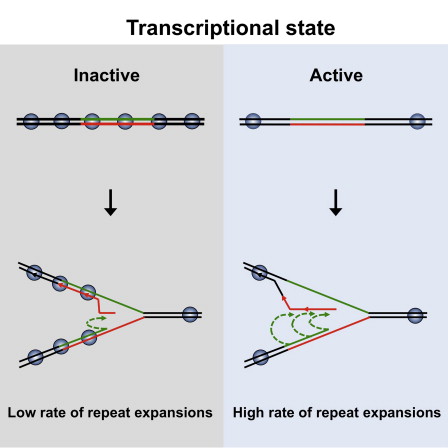A link between DNA transcription and disease-causing expansions

Scientists have believed that the lengthening of those repeats occur during DNA replication when cells divide or when the cellular DNA repair machinery gets activated. Recently, however, it became apparent that yet another process called transcription, which is copying the information from DNA into RNA, could also been involved.
A Tufts University study published online on November 20 in the journal “Cell Reports” by a research team lead by Sergei Mirkin, the White Family Professor of Biology at Tufts' School of Arts and Sciences, along with former graduate student Kartick Shah and graduate students Ryan McGuity and Vera Egorova, explores the relationship between transcription and the expansions of DNA repeats. It concludes that the active transcriptional state of a DNA segment containing a DNA repeat predisposes it for expansions. The print version of the study will be published on December 11.
“There are a great many simple repetitive motifs in our DNA, such as GAAGAAGAA or CGGCGGCGG,” says Mirkin. “They are stable and cause no harm if they stay short. Occasionally, however, they start lengthening compulsively, and these uncontrollable expansions lead to dramatic changes in genome stability, gene expression, which can lead to human disease.”
In their study, the researchers used baker's yeast to monitor the progress and the fundamental genetic machineries for transcription, replication and repair in genome functioning.
“The beauty of the yeast system is that it provides one with a practically unlimited arsenal of tools to study the mechanisms of genome functioning,” says Mirkin. “We created genetic systems to track down expansions of the repeats that were positioned in either transcribed or non-transcribed parts of reporter genes.”
After measuring the rate of repeat expansions in all these cases, the authors found that a repeat can expand under the condition when there is practically no transcription, but the likelihood of the expansion process is drastically (10-fold) higher when the reporter is transcriptionally active.
Surprisingly, however, transcription machinery does not need to physically pass through the repeat to stimulate its expansion. Thus, it is the active transcription state of the repeat-containing DNA segment, rather than RNA synthesis through the repeat that promotes expansions.
In the transcriptionally active state, DNA is packaged in chromatin more loosely than when it is transcriptionally inactive. More specifically, the density of nucleosomes along the transcribed DNA segment is significantly lower than that in the non-transcribed segment. This packaging of repetitive DNA within the transcribed areas gives much more room for DNA strand gymnastics, ultimately leading to repeat expansions.
Whatever the exact model, says Mirkin, the fact that expandable DNA repeats were always found in transcribed areas of our genome may not be that surprising after all.
This study was funded by NIH grants GM60987 and GM105473.
Shah et al., 2014, Cell Reports 9, 1-9
December 11, 2014
http://dx.doi.org/10.1016/j.celrep.2014.10.048
Tufts University, located on three Massachusetts campuses in Boston, Medford/Somerville, and Grafton, and in Talloires, France, is recognized among the Premier research universities in the United States. Tufts enjoys a global reputation for academic excellence and for the preparation of students as leaders in a wide range of professions. A growing number of innovative teaching and research initiatives span all Tufts campuses, and collaboration among the faculty and students in the undergraduate, graduate and professional programs across the university's schools is widely encouraged.
Media Contact
More Information:
http://www.tufts.edu/All latest news from the category: Health and Medicine
This subject area encompasses research and studies in the field of human medicine.
Among the wide-ranging list of topics covered here are anesthesiology, anatomy, surgery, human genetics, hygiene and environmental medicine, internal medicine, neurology, pharmacology, physiology, urology and dental medicine.
Newest articles

Recovering phosphorus from sewage sludge ash
Chemical and heat treatment of sewage sludge can recover phosphorus in a process that could help address the problem of diminishing supplies of phosphorus ores. Valuable supplies of phosphorus could…

Efficient, sustainable and cost-effective hybrid energy storage system for modern power grids
EU project HyFlow: Over three years of research, the consortium of the EU project HyFlow has successfully developed a highly efficient, sustainable, and cost-effective hybrid energy storage system (HESS) that…

After 25 years, researchers uncover genetic cause of rare neurological disease
Some families call it a trial of faith. Others just call it a curse. The progressive neurological disease known as spinocerebellar ataxia 4 (SCA4) is a rare condition, but its…





















